Long ago, deer would graze in the mountain and fields near the water of the Da River. It was because of this everyday sight that the valley was named Thung Nai, which translates to the "Valley of Deer".
|
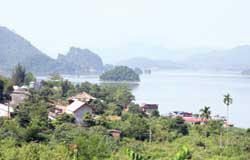
Tourists are able to relax near the tranquil waters in Thung Nai
|
Located on a section of the Da River in Cao Phong District in the northern province of Hoa Binh, Thung Nai, with its hundreds of islands and a large number of Muong ethnic people living in the region, can enchant anyone who sets foot into the land.
When the biggest hydro power plant in Southeast Asia – the Hoa Binh Hydro Power Plant – was under construction in the 1980s, the Da River was stopped up to keep water for a reservoir. The water level then rose and submerged the valley together with hundreds of mountains, turning them into islands. That’s why Thung Nai has been praised as the "Ha Long Bay of the Highlands".
Only 110km northeast of Ha Noi, Thung Nai became a favourite tourist spot for dan phuot (Vietnamese slang for backpackers who like traveling by motorbike).
|
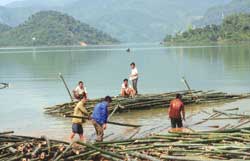
Locals harvest bamboo to use as a building material. Visitors can witness the local daily life of Thung Nai residents
|
"After two and a half hours of driving on meandering roads along the mountains, I can escape the noisy and dusty city to enjoy the purity of nature here," says Le Trung Kien, a young man who just graduated from the University of Architecture.
"I found out about the place when I joined a forum on the website. People wrote and uploaded many beautiful photographs on a topic about Thung Nai. I wanted to come here immediately after reading about it."
Kien said that he and a group of his friends were astounded by the breathtaking landscape. Islands of different shapes and sizes are embraced by the spacious reservoir. The water also brings out the green colours of the surrounding countryside.
Locals said that Thung Nai should be visited during the autumn season, when the hot summer sun no longer burns and the water level in the reservoir rises high. That is when Thung Nai really blooms.
Hoang Mai Lan, a student at the Foreign Trade University, had an unforgettable birthday when she decided to celebrate on a boat drifting on the waters in the middle of September.
|
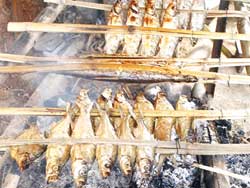
Grilled Thieu - a kind of fish which only lives in Da River - is one of Thung Nai’s special foods
|
"I’ve had a wonderful birthday in between nature and friends. We spent the day wandering about, enjoying the poetic scenery," she said.
For some other tourists, putting their hands into the clear waters while sitting on a boat or waking up at dawn to breathe in the fresh air are also enjoyable experiences.
"It’s impossible to get such pure air and space in the nation’s cities. All my worries seem to have disappeared in the boundless space of Thung Nai," said Thu Trang, a young woman from the capital.
Sightseeing spots
|
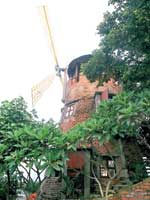
A tower on the windmill island on Thung Nai River
|
Tourists should not miss Ba Chua Thac Bo Temple (Thac Bo Goddesses Temple), which is one of several sightseeing spots in the area.
According to legend, two local ethnic women had supplied food and boats for the troops of King Le Thai To when they defeated foreign invaders in 1431. When the women died, the King praised their services and asked local residents to build a temple to worship them. Since then, boatmen often stop off at the temple to pray for smooth waters and a safe trip.
Nowadays, pilgrims still strongly believe in the Thac Bo Goddesses’ supernatural powers. They believe the Goddesses can help them with their wishes if they hear their prayers. While the original temple was submerged tens of meters under the water’s surface, the current temple attracts thousands of people nationwide every year.
|
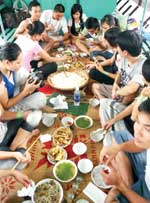
Visitors eat a meal together on a boat during a trip to the Windmill Island
|
A local boatman, Bui Van Long, said that a huge number of the pilgrims flocked to the temple from the first to the seventh lunar months.
"Since I started my job 20 years ago, almost all of my passengers are pilgrims, who come here just to pray at the temple. However, more and more true tourists have been coming in recent years," said the 38-year-old man.
Visiting the temple, tourists can also witness old Muong ethnic women displaying their farm products to sell to visitors. Their "goods" include the herbal medicines they collect from wild plants the jungle along with fresh and dried bamboo shoots.
Ten minutes by boat from the Goddesses Temple, tourists can get to Thac Bo Cave, which was recognized by the Ministry of Culture, Sports and Tourism as a national heritage site in 2008. There are different shapes of stalactites inside the 100m-long cave, and each stalactite brings about a specific sound when a visitor beats on it.
The Muong people living in the region claim that these sounds are the sounds of their ethnic gongs.
The Thac Bo floating market is also among the must-see destinations of this journey. Open every Sunday morning, the market attracts boats from around the reservoir to do business with each other.
Visitor can expand their sightseeing tours by visiting small villages of Muong and Dao ethnic people, or they can ask the boatman to take them to Ngoi Hoa Lake. Located on the top of a mountain, the lake can be seen after an hour’s climb through the green landscape.
"There is no word that can describe our pleasure when we saw the lake. While some guys in our group didn’t hesitate to jump into the water, the girls just sat on the rocks and dipped their feet into the clear water," Trang said.
Another surprise came when a cluster of small shrimps immediately swarm over to the girls’ feet and began nibbling at their skin.
"It was so amazing! We didn’t expect it; it was almost like going to the spa!" she added.
Ideal landscape
Many tourists come to Thung Nai not only to witness the wonderful poetic landscape, but also to find a perfect backdrop for their photographs.
Minh Quan, a television reporter, got sunburned waiting for the right light for his images.
"I don’t want to use words to talk about Thung Nai, so I’ll just upload some pictures I took during my trip. I’m pretty sure that many people will want to visit the place once they see my images," said Quan, who brings along his photography equipment whenever he travels with his friends at the Vespa Cau Giay Family – a club for those interested in the Italian vintage scooters.
For Nguyen Thong Nhat, a professional photographer, the most impressive moment was when he spent the Mid-Autumn night on the reservoir. "The water surface looked like it was inlaid with gold. The twinkling moonlight was everywhere," he said.
And of course, he didn’t miss a chance to capture the scenery of the "Ha Long Bay of the Highlands".
Some other photographers said the Coi Xay Gio (Windmill) guest house, located on a small island on the reservoir, was an ideal place to capture the landscape at different times of day.
The guest house’s owner is a Ha Noi resident, who also enjoys travelling. Together with some friends, he purchased some land on one of the islands and built a stilt house on it in 2000.
"More and more tourists have dropped by my island, which is quite eye-catching with a red-brick windmill. They asked me for a place to spend the night. So since then I’ve turned the house into a small guesthouse," said owner Tran Duc Duy.
The Windmill guest house attracts visitors not only for its nice location, but also for its local specialities, such as fermented fish and grilled and smoked fish, served with ruou can (a home-made rice wine in a jar, drunk with bamboo straws).
Visitors also should not miss a chance to taste the crispy roasted meat of the Muong boar. Although it is a domestic animal, the Muong people keep them in a wild environment and never let them grow bigger than 20kg.
The Windmill guest house offers a package for tourists for a very reasonable price, from VND250,000-300,000 (about US$13). The package includes a bed, three meals and a sightseeing boat.
His three stilt houses are large enough for 100 people to sleep in each night. Duy said that he had re-invested all his profits to upgrade the guest houses.
Tourism development According to the chairman of Thung Nai Commune’s People Committee, Bui Van Nhan, Hoa Binh Province has some guidelines to develop tourism in the area. However, some projects have not been implemented due to the province’s limited budget.
"So far, a 25km road from Binh Thanh Commune to Thung Nai Commune and a tourism wharf have been completed in 2007," Nhan said.
Thanks to the road, more and more tourists have come to the area over the past few years.
"Before the road was completed, most tourists came here by the waterway. Everything changed when the road was opened: now, more and more people visit Thung Nai by land."
There were no figures, but Nhan said that Thung Nai greeted its largest-ever number of tourists in 2009.
Realising the region’s tourism potential, the local authorities submitted a plan to develop infrastructure as well as to call on investments in the area.
A plan to develop cultural tourism at six Muong ethnic villages was also being thrown around.
"Together with its natural potential, we will try to use the local ethnic culture as a key element to develop tourism here," Nhan said.